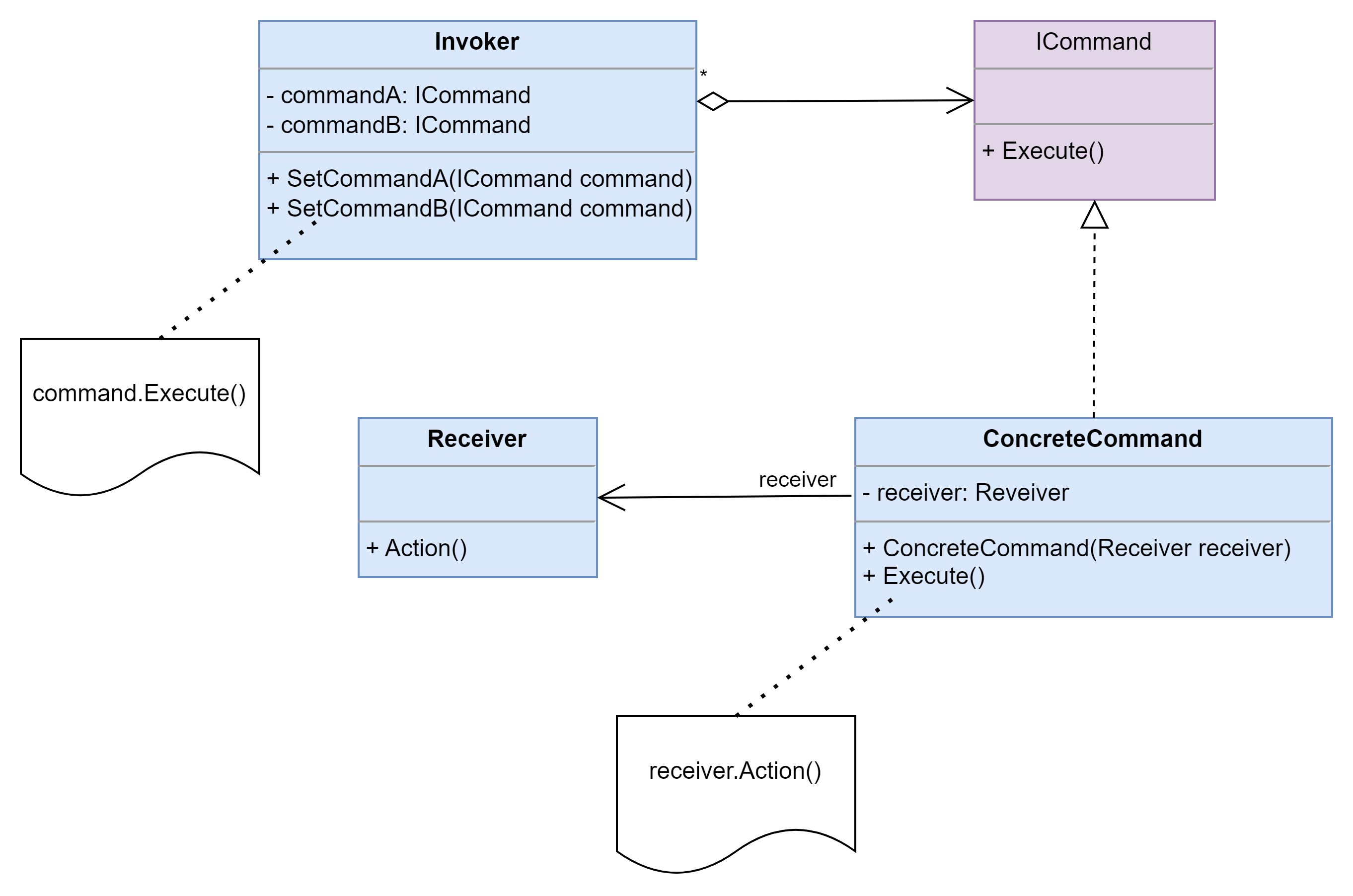命令模式 (Command Pattern) - 请求发送者与接收者解耦
将一个请求封装为一个对象,从而让我们可用不同的请求对客户进行参数化;对请求排队或者记录请求日志,以及支持可撤销的操作。命令模式是一种对象行为型模式,其别名为动作(Action)模式或事务(Transaction)模式。
结构图
- ICommand(命令接口):命令接口一般是一个抽象类或接口,在其中声明了用于执行请求的execute()等方法,通过这些方法可以调用请求接收者的相关操作。
- ConcreteCommand(具体命令类):具体命令类是命令接口的实现类,实现了在命令接口中声明的方法,它对应具体的接收者对象,将接收者对象的动作绑定其中。在实现execute()方法时,将调用接收者对象的相关操作(Action)。
- Invoker(调用者):调用者即请求发送者,它通过命令对象来执行请求。一个调用者并不需要在设计时确定其接收者,因此它只与命令接口之间存在关联关系。在程序运行时可以将一个具体命令对象注入其中,再调用具体命令对象的execute()方法,从而实现间接调用请求接收者的相关操作。
- Receiver(接收者):接收者执行与请求相关的操作,它具体实现对请求的业务处理。
命令模式的本质是对请求进行封装,一个请求对应于一个命令,将发出命令的责任和执行命令的责任分割开。每一个命令都是一个操作:请求的一方发出请求要求执行一个操作;接收的一方收到请求,并执行相应的操作。命令模式允许请求的一方和接收的一方独立开来,使得请求的一方不必知道接收请求的一方的接口,更不必知道请求如何被接收、操作是否被执行、何时被执行,以及是怎么被执行的。
示例
using System;
namespace DesignPatterns.Command
{
// The Command interface declares a method for executing a command.
public interface ICommand
{
void Execute();
}
// Some commands can implement simple operations on their own.
class SimpleCommand : ICommand
{
private string _payload = string.Empty;
public SimpleCommand(string payload)
{
this._payload = payload;
}
public void Execute()
{
Console.WriteLine($"SimpleCommand: See, I can do simple things like printing ({this._payload})");
}
}
// However, some commands can delegate more complex operations to other
// objects, called "receivers."
class ComplexCommand : ICommand
{
private Receiver _receiver;
// Context data, required for launching the receiver's methods.
private string _a;
private string _b;
// Complex commands can accept one or several receiver objects along
// with any context data via the constructor.
public ComplexCommand(Receiver receiver, string a, string b)
{
this._receiver = receiver;
this._a = a;
this._b = b;
}
// Commands can delegate to any methods of a receiver.
public void Execute()
{
Console.WriteLine("ComplexCommand: Complex stuff should be done by a receiver object.");
this._receiver.DoSomething(this._a);
this._receiver.DoSomethingElse(this._b);
}
}
// The Receiver classes contain some important business logic. They know how
// to perform all kinds of operations, associated with carrying out a
// request. In fact, any class may serve as a Receiver.
class Receiver
{
public void DoSomething(string a)
{
Console.WriteLine($"Receiver: Working on ({a}.)");
}
public void DoSomethingElse(string b)
{
Console.WriteLine($"Receiver: Also working on ({b}.)");
}
}
// The Invoker is associated with one or several commands. It sends a
// request to the command.
class Invoker
{
private ICommand _onStart;
private ICommand _onFinish;
// Initialize commands.
public void SetOnStart(ICommand command)
{
this._onStart = command;
}
public void SetOnFinish(ICommand command)
{
this._onFinish = command;
}
// The Invoker does not depend on concrete command or receiver classes.
// The Invoker passes a request to a receiver indirectly, by executing a
// command.
public void DoSomethingImportant()
{
Console.WriteLine("Invoker: Does anybody want something done before I begin?");
if (this._onStart is ICommand)
{
this._onStart.Execute();
}
Console.WriteLine("Invoker: ...doing something really important...");
Console.WriteLine("Invoker: Does anybody want something done after I finish?");
if (this._onFinish is ICommand)
{
this._onFinish.Execute();
}
}
}
class Program
{
static void Main(string[] args)
{
// The client code can parameterize an invoker with any commands.
Invoker invoker = new Invoker();
invoker.SetOnStart(new SimpleCommand("Say Hi!"));
Receiver receiver = new Receiver();
invoker.SetOnFinish(new ComplexCommand(receiver, "Send email", "Save report"));
invoker.DoSomethingImportant();
}
}
}运行结果
1
2
3
4
5
6
7
Invoker: Does anybody want something done before I begin?
SimpleCommand: See, I can do simple things like printing (Say Hi!)
Invoker: ...doing something really important...
Invoker: Does anybody want something done after I finish?
ComplexCommand: Complex stuff should be done by a receiver object.
Receiver: Working on (Send email.)
Receiver: Also working on (Save report.)
总结
命令模式是一种使用频率非常高的设计模式,它可以将请求发送者与接收者解耦,请求发送者通过命令对象来间接引用请求接收者,使得系统具有更好的灵活性和可扩展性。
优点
- 降低系统的耦合度。由于请求者与接收者之间不存在直接引用,因此请求者与接收者之间实现完全解耦,相同的请求者可以对应不同的接收者,同样,相同的接收者也可以供不同的请求者使用,两者之间具有良好的独立性。
- 新的命令可以很容易地加入到系统中。由于增加新的具体命令类不会影响到其他类,因此增加新的具体命令类很容易,无须修改原有系统源代码,甚至客户类代码,满足“开闭原则”的要求。
- 可以比较容易地设计一个命令队列或宏命令(组合命令)。
- 为请求的撤销(Undo)和恢复(Redo)操作提供了一种设计和实现方案。
缺点
使用命令模式可能会导致某些系统有过多的具体命令类。因为针对每一个对请求接收者的调用操作都需要设计一个具体命令类,因此在某些系统中可能需要提供大量的具体命令类,这将影响命令模式的使用。
适用场景
- 系统需要将请求调用者和请求接收者解耦,使得调用者和接收者不直接交互。请求调用者无须知道接收者的存在,也无须知道接收者是谁,接收者也无须关心何时被调用。
- 系统需要在不同的时间指定请求、将请求排队和执行请求。一个命令对象和请求的初始调用者可以有不同的生命期,换言之,最初的请求发出者可能已经不在了,而命令对象本身仍然是活动的,可以通过该命令对象去调用请求接收者,而无须关心请求调用者的存在性,可以通过请求日志文件等机制来具体实现。
- 系统需要支持命令的撤销(Undo)操作和恢复(Redo)操作。
- 系统需要将一组操作组合在一起形成宏命令。
This post is licensed under CC BY 4.0 by the author.
